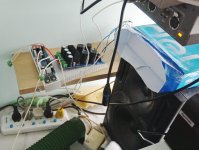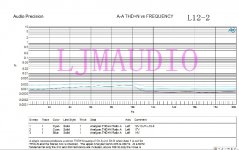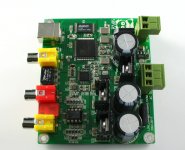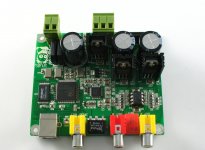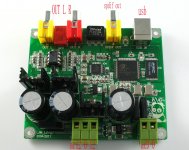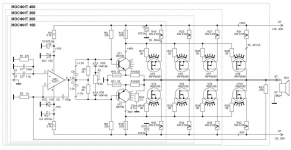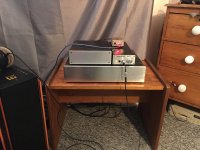Dear LJM
I tried to contact you via PM. Anyway, is this board made by you ? IRS2092S 500W Mono Channel Digital Amplifier Class D HIFI Power Amp Board + FAN | eBay
I tried to contact you via PM. Anyway, is this board made by you ? IRS2092S 500W Mono Channel Digital Amplifier Class D HIFI Power Amp Board + FAN | eBay
Hello Ljm_Ljm
I have your L20 and L15D amplifiers. I love them, thank you! Is the Preamp 9 good to connect to the L20 and L15D amplifiers?
I think there is no problem.
Just pay attention to the PREAMP 9 voltage amplification is GAIN VOLTAGE 10
How does it sound?
Especially compared to your other amplifiers
Personally, I recommend L20SE
L12-2 smaller Smaller distortion than LME49810
MX50X2 more lasting appeal
Attachments
DIY 32BIT-384K USBDAC CM6631A+AKM4490
INPUT USB
OUTPUT Analog output stereo
Suit to launch and a specially designed for the USB interface of DAC decoder
USB USES CM6631A, CM6631A is C - MEDIA company production of special products for HIEND USB audio source
C - MEDIA is one of making sound audio established manufacturers, has a wide compatibility with many big companies
Such as Microsoft, apple and so on, have good compatibility, and compatible with all software is good.
DIY products are pay attention to the compatibility and usability, or even better performance again, is not working.
CM6631A under Windows 7 version of the need to install the driver. You can find the owner.
WINDOWS comes with 10 drivers, and friendly interface, convenient operation. Both use both.
CM6631A support 384 k sampling, is the highest standard of sampling.
In order to match the high sampling of high-performance ?
INPUT USB
OUTPUT Analog output stereo
Suit to launch and a specially designed for the USB interface of DAC decoder
USB USES CM6631A, CM6631A is C - MEDIA company production of special products for HIEND USB audio source
C - MEDIA is one of making sound audio established manufacturers, has a wide compatibility with many big companies
Such as Microsoft, apple and so on, have good compatibility, and compatible with all software is good.
DIY products are pay attention to the compatibility and usability, or even better performance again, is not working.
CM6631A under Windows 7 version of the need to install the driver. You can find the owner.
WINDOWS comes with 10 drivers, and friendly interface, convenient operation. Both use both.
CM6631A support 384 k sampling, is the highest standard of sampling.
In order to match the high sampling of high-performance ?
Attachments
I designed a small power amplifier。
It uses a pair of VISHAY IRFP240 IRFP9240。
It uses the CFP input, and the suspension of the output, similar to LME49830 structure.
It works in very stable.
In the +-56V voltage.it is can out 150W 8R。
PCB board area 63*78MM only
what is the gain of the board? the supplier said that 32 times (30dB) and i noticed a 330 ohm and 10kohm Ri and Rf so Ri/Rf=32, i think he is correct.. but i wonder which resistor or resistor are responsible for gain adjusment? can you show them for me on the pcb with their values so i want to increase the gain
Can this be used with lower voltage supply of say +/-35v? What would be the power output?
thanks
hi, can you help me about the gain of this L7 amp?
Attachments
My L7 still hasn't blown up
Great!
Actually, when given a correct PS voltage, the L7 seems to be very safe.
Always with a 30-0-30 trafo?
according to my knowledge, the gain of the L7 is about 30 times (30dB), do you think that this amount of gain is enough? do i need a separate preamp? i am a ordinary home user for stereo
Great!
Actually, when given a correct PS voltage, the L7 seems to be very safe.
Always with a 30-0-30 trafo?
well I had a 45-0-45 trafo for about 3 hours at the begining, then I swapped it out for a 30-0-30.
according to my knowledge, the gain of the L7 is about 30 times (30dB), do you think that this amount of gain is enough? do i need a separate preamp? i am a ordinary home user for stereo
You are going to want a preamp, not to give you more gain but to quieten it down! I have a simple lehmann preamp that I built on mine that is also a headphone amp, a little DAC I built, and it works great as a little stack.
Attachments
well I had a 45-0-45 trafo for about 3 hours at the begining, then I swapped it out for a 30-0-30.
You are going to want a preamp, not to give you more gain but to quieten it down! I have a simple lehmann preamp that I built on mine that is also a headphone amp, a little DAC I built, and it works great as a little stack.
Your rig is great, thanks for advice
Unlike L 20 L7 is great sounding.
Is L20 no good?
Hi,
Does anyone can help me with my L15D boards?
I made two of them few months ago and they work well on a test support. They are feed with a connex SMPS800RE at +-58V on 8ohm load KEF speakers.
Few days ago one a the 2 boards starting to have trouble, the led starting to blink and then goes off. However, I couldn't ear any problem in the sound. All is good with power supply voltage and board temps seems good (nothing burning!).
I made few tests with the board and when I start it, the led is blue but it seems to fail slowly until temp is stabilizing and then led is off.
What can be the cause of this behaviour?
PS: as I understand, the blue LED indicate that PWM oscillation is present. So how my board can steel work with no PWM signal?
Thanks, Arno
Does anyone can help me with my L15D boards?
I made two of them few months ago and they work well on a test support. They are feed with a connex SMPS800RE at +-58V on 8ohm load KEF speakers.
Few days ago one a the 2 boards starting to have trouble, the led starting to blink and then goes off. However, I couldn't ear any problem in the sound. All is good with power supply voltage and board temps seems good (nothing burning!).
I made few tests with the board and when I start it, the led is blue but it seems to fail slowly until temp is stabilizing and then led is off.
What can be the cause of this behaviour?
PS: as I understand, the blue LED indicate that PWM oscillation is present. So how my board can steel work with no PWM signal?
Thanks, Arno
Last edited:
Arno,
I had the same problem with one out of six boards. I have read this means carrier detection loss - as you suggest. I removed the board immedately so I cannot say if it continued working.
I soldered a new chip and the board works stable. Don´t know what the reason was. The chips are cheap enough.
It is hard to say what the source of the parts is. Are the parts fake or genuine? No answer. But this is a cheap try.
-helmut
I had the same problem with one out of six boards. I have read this means carrier detection loss - as you suggest. I removed the board immedately so I cannot say if it continued working.
I soldered a new chip and the board works stable. Don´t know what the reason was. The chips are cheap enough.
It is hard to say what the source of the parts is. Are the parts fake or genuine? No answer. But this is a cheap try.
-helmut
Arno,
I had the same problem with one out of six boards. I have read this means carrier detection loss - as you suggest. I removed the board immedately so I cannot say if it continued working.
I soldered a new chip and the board works stable. Don´t know what the reason was. The chips are cheap enough.
It is hard to say what the source of the parts is. Are the parts fake or genuine? No answer. But this is a cheap try.
-helmut
Thank you for you answer Helmut, my first intuition was a chip fail but I wanted another opinion before trying to change it. I will buy some spares and tell you if it's ok.
Last edited:
May I recommend that you buy at least one spare chip for each board.
I had fried one earlier by a wiring error I had made and had ordered some. They were already phased out by popular retailers, so I reordered some more - which already took them some weeks.
The companies are phasing out chips at a phenomenal rate, since new stuff hits the market every day.
Also get a few mosfets into the bargain. Everything else is common.
-h
I had fried one earlier by a wiring error I had made and had ordered some. They were already phased out by popular retailers, so I reordered some more - which already took them some weeks.
The companies are phasing out chips at a phenomenal rate, since new stuff hits the market every day.
Also get a few mosfets into the bargain. Everything else is common.
-h
- Home
- Vendor's Bazaar
- LJM Audio
